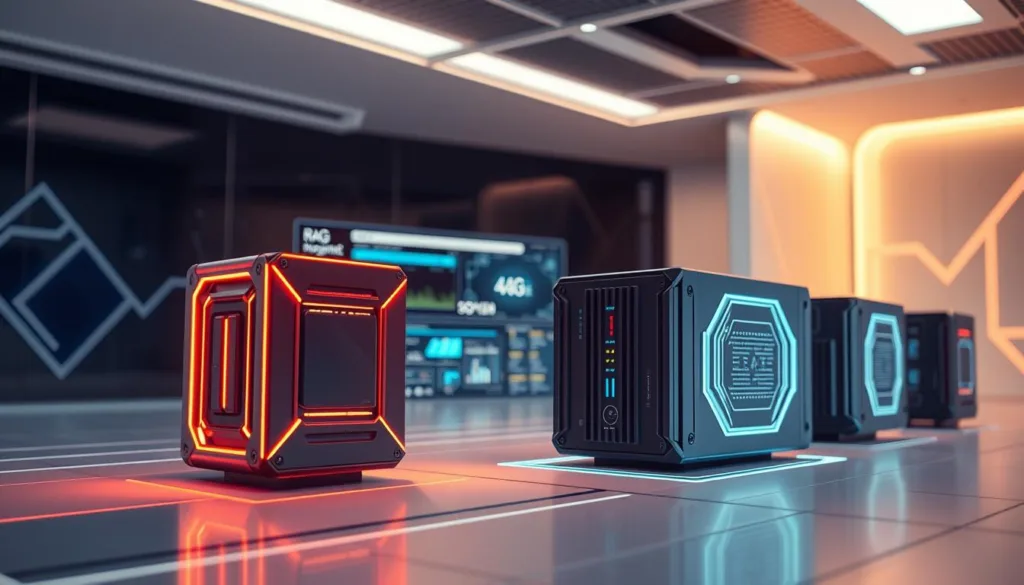RAG models are a key part of artificial intelligence. They use a knowledge graph to store and find information. This makes Agentic AI better at understanding and using human language.
This technology could change how we use artificial intelligence. It makes processing and creating language more efficient. Artificial intelligence gets smarter with RAG models.

RAG models help artificial intelligence systems understand human language better. They use a knowledge graph to find and store information. This makes them a key part of today’s AI systems.
Adding RAG models to Agentic AI changes how we talk to machines. It makes them smarter and more able to respond.
Introduction to RAG Models
RAG models are made to understand and create human-like language. They get better with machine learning. This lets AI systems learn from big datasets and make better choices.
Using RAG models in Agentic AI improves how machines talk to us. They can understand and answer human language better.
Key Takeaways
- RAG models enhance the capabilities of Agentic AI systems
- Artificial intelligence systems can benefit from the integration of RAG models
- RAG models use a knowledge graph to store and retrieve information
- Machine learning algorithms are used to improve the performance of RAG models
- RAG models can transform the way we interact with artificial intelligence systems
- Artificial intelligence systems that incorporate RAG models can make more informed decisions
Understanding RAG Models in Modern AI Systems
RAG models have changed the Artificial Intelligence (AI) world. They let machines understand and create language like humans. At their heart, RAG models use a knowledge graph. This graph stores and finds information with Natural Language Processing (NLP).
This setup helps RAG models grasp language’s context and subtleties. They are now a crucial part of today’s AI systems.
By combining RAG models with Knowledge Graphs, AI can reason and make smart guesses from lots of data. This has boosted areas like answering questions, summarizing texts, and creating dialogues. AI systems can now give more precise and helpful answers to users.
- Improved language understanding and generation capabilities
- Enhanced ability to reason and draw inferences from data
- Increased accuracy and reliability in AI-powered applications
RAG models are getting better, and we’ll see new uses soon. They can understand and create language like us. This means RAG models will change how we talk to machines and find information.
The Synergy Between RAG and Agentic AI
The mix of RAG models with Agentic AI could change Artificial Intelligence forever. Together, they make AI systems stronger and more efficient. RAG models help Agentic AI understand the world better and solve complex problems.
Some big advantages of this team-up are:
- Improved decision-making: RAG models give Agentic AI better info, leading to smarter choices.
- Enhanced problem-solving: This combo helps AI systems tackle tough problems more effectively.
- Increased efficiency: RAG models and Agentic AI work together to make processes smoother and cut down on human help.
The uses of RAG-powered Agentic AI are endless, from understanding language to making decisions and solving problems. As AI keeps growing, the partnership between RAG models and Agentic AI will become even more crucial. This blend of technologies will help us build smarter AI that can handle big challenges and make our lives better.
Key Benefits of Implementing RAG Models
Using RAG models in AI systems can greatly improve their performance and efficiency. These models help organizations make better decisions by enhancing information retrieval. They also make AI systems more accurate and reliable, reducing errors.
Some main advantages of RAG models are:
- They improve information retrieval, helping organizations use data more effectively.
- They increase accuracy and reliability, lowering the chance of mistakes.
- They allow for real-time updates, keeping organizations current with new information.
RAG models work well with machine learning algorithms. This combination makes AI systems smarter and more adaptable.
In summary, RAG models significantly boost AI system performance and efficiency. They help organizations make better decisions and stay competitive. By using RAG and machine learning, AI systems become more intelligent and responsive.
How RAG Models Transform Decision Making
RAG models are changing Artificial Intelligence. They give more accurate and reliable info for making decisions. This leads to better results in many areas.
By using RAG models, AI systems can make smarter choices. This means better outcomes in different fields.
RAG models help AI systems make better decisions. They can look at lots of data, find patterns, and predict outcomes. This leads to more informed choices.
Some key benefits of RAG models in Decision Making are:
- Improved accuracy and reliability of predictions
- Enhanced ability to analyze complex data sets
- Increased efficiency in Decision Making processes
In Artificial Intelligence, RAG models are great for predictive analytics and recommender systems. They help organizations stay ahead and make better choices.
Technical Architecture and Implementation Strategies
Implementing RAG models needs a solid technical plan. This plan should design a system that can handle lots of data and grow as needed. A strong technical base is key for RAG models to work well, and this is where strategies come in.
Building a knowledge base is a big part of technical architecture for RAG. It’s about choosing the right data sources, storage, and how to get the data. With RAG, companies can make one knowledge base that works with their current systems. This makes getting and sharing information easy.
Key Components of Technical Architecture
- Data ingestion and processing
- Knowledge graph construction
- Query optimization and ranking
Good strategies for using RAG are also important. This means making RAG work with what you already have, making it fast, and making it grow. By using RAG and a good technical plan, companies can use their data better and grow their business.
By focusing on technical architecture and strategies, companies can build a strong base for RAG. This lets them get better at finding information, be more accurate, and keep their knowledge up to date. With RAG, the future is bright, and the right plan can make a big difference.
Real-world Applications of RAG-powered Agentic AI
RAG models have many real-world applications across industries like healthcare, finance, and education. In healthcare, they can analyze medical records and suggest personalized treatments. In finance, they aid in risk assessment and portfolio management. This integration of RAG models with Agentic AI leads to better performance and efficiency.
Some key areas where RAG models are used include:
- Customer service: RAG-powered chatbots offer personalized support and answer complex questions.
- Language translation: RAG models enhance machine translation, enabling more accurate language understanding.
- Recommendation systems: RAG-powered Agentic AI suggests products or services based on user behavior and preferences.

The use of RAG models in real-world applications is changing how we interact with AI. As the technology advances, we’ll see even more innovative uses of RAG-powered Agentic AI in the future.
Overcoming Common Challenges in RAG Implementation
Starting a RAG model can be tricky, and you might face some hurdles. To make it work, you need to plan well and keep an eye on things. This way, you can beat any problems that come up.
Getting good data is key to making RAG models work. High-quality data is needed to train and check these models. Also, systems need to grow with your data and traffic.
To tackle these issues, you can try a few things. Here’s what works:
- Use strong data quality checks to make sure your data is right and reliable.
- Build systems that can grow with your data and traffic.
- Make your system run better with tricks like caching and query optimization.
By tackling these problems and using smart strategies, you can make RAG work well. This can help your business make better choices, improve customer service, and stay ahead in the market.
Best Practices for RAG Model Deployment
Deploying RAG models requires careful steps. Proper data preparation is key. This means cleaning, engineering, and normalizing the data.
Model testing and validation are also crucial. You need to check how well the model works on test data. This helps spot problems and fix them before it’s too late.
Here are more tips for a smooth deployment:
- Keep an eye on how the model performs and update it when needed.
- Use cross-validation to avoid the model fitting too closely to the training data.
- Host the model in the cloud for better scalability and flexibility.
By sticking to these practices, you can make the most of RAG models. They can bring real value to businesses.

Measuring Success and ROI of RAG Systems
To see how well RAG systems work, it’s key to set clear goals. We track things like how often the system is up, how fast it answers queries, and how happy users are. This helps find what needs work and make the RAG systems better.
For ROI, we look at the total cost of having RAG systems. This includes the cost to set it up, keep it running, and the day-to-day expenses. We also look at the good things RAG systems bring, like better decisions, happier customers, and more money. By comparing these, we can figure out if RAG systems are worth it.
Important things to think about when checking if RAG systems are doing well include:
- How well the system can grow and change
- How accurate and good the data is
- How well users like and use the system
- How well it works with other systems and stuff
By looking at these points and setting clear goals, we can really see how well RAG systems are doing. This helps us make smart choices to help our business grow.
| Success Metrics | Description |
|---|---|
| System Uptime | Percentage of time the system is available and accessible |
| Query Response Time | Average time taken for the system to respond to user queries |
| User Satisfaction | Level of satisfaction among users with the system’s performance and functionality |
Future Trends in RAG Technology
The future of RAG technology looks bright, with Artificial Intelligence leading the way. RAG models are getting better, opening doors to new uses in edge AI and explainable AI. These steps will make AI systems work better and faster, helping us make smarter choices.
Some trends we might see in RAG technology include:
- RAG models being used more in real-time data analysis
- RAG models working together with other AI like machine learning and natural language processing
- More advanced RAG models that can handle tough data and situations
RAG technology is set to change many industries, from healthcare to finance. It’s great at giving us accurate and trustworthy info. This makes RAG a key player in
The future of RAG technology is thrilling and full of chances. As experts keep pushing the limits, we’ll see big leaps in Artificial Intelligence. RAG models will be at the heart of these advancements.
Conclusion: Embracing RAG Models for AI Innovation
RAG models are changing how AI systems work. They make decisions better and faster. These models mix knowledge and creation, opening up a new world of AI innovation.
Companies that use RAG technology can find new insights and make better choices. They will also stay ahead in a fast-changing world.
The future of AI looks bright, and RAG models will be key. They will help us solve big problems and make smarter choices. By combining RAG and Agentic AI, we can explore new possibilities. This will shape the future of artificial intelligence.
FAQ
What are RAG models?
RAG models, or Retrieval-Augmented Generation models, are a new kind of artificial intelligence. They use a knowledge graph to store and find information. This could change AI by making it more efficient and able to speak like humans.
How do RAG models enhance the capabilities of Agentic AI?
RAG models help Agentic AI by giving it better and more reliable information. This lets AI systems make smarter choices and speak more like humans. Together, RAG and Agentic AI can create more powerful AI.
What are the key benefits of implementing RAG models?
Using RAG models brings many benefits. They improve how AI finds and uses information, making it more accurate and reliable. They also keep knowledge up to date in real time. This can make AI’s decisions better.
How can RAG models be implemented in AI systems?
To add RAG models to AI systems, you need to build a knowledge base. Then, you integrate the models with the AI. It’s important to solve problems like data quality and system size to make it work well.
What are the real-world applications of RAG-powered Agentic AI?
RAG-powered Agentic AI has many uses in fields like healthcare, finance, and education. It can make AI systems work better and give more accurate information for making decisions.
How can the success and ROI of RAG systems be measured?
To see how well RAG systems do, you need to track important signs of success. Use methods to measure their impact and create a way to figure out their return on investment. This helps organizations know if their RAG systems are worth it.
What are the future trends in RAG technology?
RAG technology is set to grow, with new uses in areas like edge AI and explainable AI. It will also get better at making AI systems more efficient and effective. But, we need to solve its challenges to keep AI moving forward.

